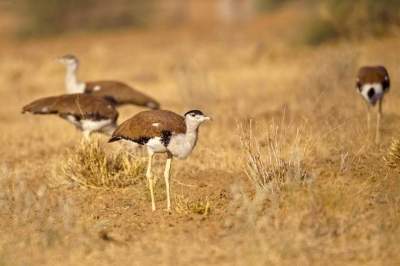New Delhi (IANS) The Great Indian Bustard (GIB) or Great Indian Bast*** this was the main concern of the Indian delegation that was participating in the XIIth Conference of the ‘International Council for Bird Preservation’ meeting in Tokyo in May 1960, where the idea was born that each country should designate its own ‘national bird’.
Our politically correct babus were petrified that people would mispronounce the Bustard’s name as Bast***. And the poor bird lost its first battle.
Legendary ornithologist Salim Ali had recommended Great Indian Bustard (Ardeotis Nigriceps) as the ‘national bird’ of India. “The purpose was to pinpoint public interest and attention to some particular species that stood in the greatest need of protection in each country, especially where it was threatened with extinction owing to public apathy or direct human persecution. The Great Indian Bustard is a species that merits this distinction. This Bustard is a large and spectacular bird, indigenous to India, whose numbers, in spite of the legislative ban on its killing, are dwindling at an alarming rate due to poaching by vandalistic gunners and also encroachment upon its natural habitats. It needs an urgent nation-wide effort to save the bird from its impending doom,” appealed Ali.
Unfortunately, Ali’s warning went unheeded and India chose the beautiful peacock as the National Bird in 1962 and the GIB lost to its more colourful cousin because of its name. Despite the Bird Man, Salim Ali’s, several appeals, nothing was done. In India, the bird was historically found in Punjab, Haryana, Uttar Pradesh, Madhya Pradesh, Chhattisgarh, Odisha, Andhra Pradesh, Rajasthan, Gujarat, Maharashtra, Karnataka and Tamil Nadu. Today it is restricted to isolated pockets of Gujarat and Rajasthan (shared with Pakistan). In 1969, the population of this bird was 1,260 adults. And now? It’s about 150 and its presence restricted to the Kutch of Gujarat and Desert National Park in Jaisalmer, Rajasthan.
In February, the UN wildlife conference had accepted India’s proposals to include the Great Indian Bustard, the Asian elephant, and the Bengal florican in a list of migratory species targeted for enhanced transboundary conservation efforts.
This was the time for me to meet GIB. A chance to click the endangered bird. Together with veteran wildlife photographer and guide Kamal Sahansi, we reached Sum, about 40 km from Jaisalmer in search of the GIB. To our dismay, we found that the Desert National Park (DNP) was closed indefinitely for the public. Reason, the authorities were still searching and collecting eggs of GIB scattered in DNP under the Species Recovery Programme. Conservationists hope the GIB chicks will eventually become fully grown adults and survive in the wild.
We were now forced to take another route to catch a glimpse of the great bird. Our effort yielded success. After a two-hour bumpy drive through unmarked roads in the Thar desert and scrubs, we decided to disembark and climb the nearby dunes on foot. After the third dune had been climbed, we got the glimpse of four majestic GIB’s in an open field. They stood out for their proud gait, long white fur necks and blackish crowns. And there also were chinkaras (Indian Gazelle) around. It was sheer luck to watch Rajasthan’s state bird and animal together in single visual sweep.
GIB is the heaviest flying bird in the world. An omnivore, it is a friend of farmers as it loves eating insects. Locals call them ‘Godawan’. The GIB is a magnificent bird with males sometimes as tall as 5 feet and weighing 15-17 kilos. The GIB is a k-selected species, which in layman’s terms means a species that invests significant energy in one offspring at a time, and has a relatively long life span. They can live for up to 40 years, and females produce one chick a year.
According to the IUCN Red List (the world’s most comprehensive inventory of the conservation status of species), the GIB critically endangered. In India, this state bird of Rajasthan is listed in Schedule I of the Wildlife Protection Act. The bird flies across the border to Pakistan-part of its natural habitat. Once across the border, it is punished for this folly-and for its name.
The Red List report for 2017 raised alarm over rampant poaching of the bustards in Pakistan, stating, “Current levels of hunting may result in the extinction of even the largest western Indian population in the next 15-20 years.” It noted that “high-intensity poaching still continues in Pakistan, where 49 birds were hunted of 63 that were sighted over a period of four years.”
On February 21, 2020, during the UN-sponsored Conference of the Parties to the Convention on the Conservation of Migratory Species of Wild Animals (CMSCOP13), of which Pakistan is also a party, India asked Pakistan to work on conserving the GIB: “We are greatly worried about its killing and poaching that is taking place in Pakistan. Now when GIB has been included in appendix one of the CMS, it is the duty of all parties to this treaty, even mandatory, to do their bit for conservation.” Too late.
Still there is hope. Last year five chicks and in April this year, two chicks, were born-the first GIB births in captivity through artificial hatching. The species recovery programme is part of the Rajasthan government’s plan to steadily build up a population of 25 bustards in captivity and release them in the wild. The GIB project is a joint effort of the Rajasthan wildlife department, Dehradun’s Wildlife Institute of India, the Union Ministry of Environment, Forest and Climate Change and the Abu Dhabi-based International Fund for Houbara Conservation (IFHC).
Hopefully, in the near future we will see more GIBs as concerned agencies are working on a war footing to save this species. Authorities have also radio tagged a few GIBs as it is suspected that it flies into neighboring Pakistan and gets hunted there. The money and resources are available, it just needs the political will. Not saving the Great Indian Bustard will be a dreadful failure. It would be the first species in India since the Cheetah and the pink-headed duck to pass into oblivion.

